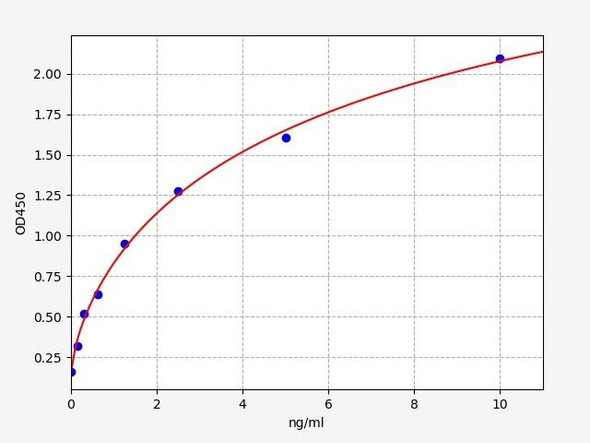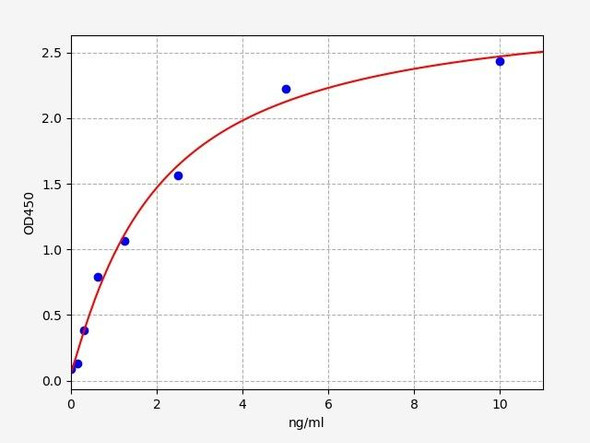Human M-AChR M1 (Muscarinic Acetylcholine Receptor M1) ELISA Kit (HUES02288)
- SKU:
- HUES02288
- Product Type:
- ELISA Kit
- Size:
- 96 Assays
- Uniprot:
- P11229
- Sensitivity:
- 0.19ng/mL
- Range:
- 0.31-20ng/mL
- ELISA Type:
- Sandwich
- Reactivity:
- Human
- Sample Type:
- Serum, plasma and other biological fluids
- Research Area:
- Cell Biology
Description
Human M-AChR M1 (Muscarinic Acetylcholine Receptor M1) ELISA Kit
The Human M-AChR M1 (Muscarinic Acetylcholine Receptor M1) ELISA Kit is a reliable tool for detecting levels of the M1 subtype of the muscarinic acetylcholine receptor in human serum, plasma, and cell culture supernatants. This kit offers high sensitivity and specificity, ensuring accurate and reproducible results for a variety of research applications.The M1 subtype of the muscarinic acetylcholine receptor plays a crucial role in various physiological processes, including neurotransmission, smooth muscle contraction, and glandular secretion.
Dysregulation of this receptor has been implicated in conditions such as Alzheimer's disease, schizophrenia, and Parkinson's disease, making it a valuable biomarker for studying these disorders and exploring potential therapeutic interventions.Overall, the Human M-AChR M1 ELISA Kit is a valuable tool for researchers studying the role of the muscarinic acetylcholine receptor M1 subtype in health and disease, offering reliable and accurate measurements for their research needs.
| Assay type: | Sandwich |
| Format: | 96T |
| Assay time: | 4.5h |
| Reactivity: | Human |
| Detection Method: | Colormetric |
| Detection Range: | 0.31-20 ng/mL |
| Sensitivity: | 0.19 ng/mL |
| Sample Volume Required Per Well: | 100µL |
| Sample Type: | Serum, plasma and other biological fluids |
| Specificity: | This kit recognizes Human M-AChR M1 in samples. No significant cross-reactivity or interference between Human M-AChR M1 and analogues was observed. |
This ELISA kit uses Sandwich-ELISA as the method. The micro ELISA plate provided in this kit has been pre-coated with an antibody specific to Human M-AChRM1. Standards or samples are added to the appropriate micro ELISA plate wells and combined with the specific antibody. Then a biotinylated detection antibody specific for Human M-AChRM1 and Avidin-Horseradish Peroxidase (HRP) conjugate are added to each micro plate well successively and incubated. Free components are washed away. The substrate solution is added to each well. Only those wells that contain Human M-AChRM1, biotinylated detection antibody and Avidin-HRP conjugate will appear blue in color. The enzyme-substrate reaction is terminated by adding Stop Solution and the color turns yellow. The optical density (OD) is measured spectrophotometrically at a wavelength of 450 nm ± 2 nm. The OD value is proportional to the concentration of Human M-AChRM1. The concentration of Human M-AChRM1 in samples can be calculated by comparing the OD of the samples to the standard curve.
| UniProt Protein Function: | mAChR m1: The muscarinic acetylcholine receptor mediates various cellular responses, including inhibition of adenylate cyclase, breakdown of phosphoinositides and modulation of potassium channels through the action of G proteins. Primary transducing effect is Pi turnover. Belongs to the G-protein coupled receptor 1 family. Muscarinic acetylcholine receptor subfamily. CHRM1 sub-subfamily. |
| UniProt Protein Details: | Protein type:GPCR, family 1; Membrane protein, integral; Membrane protein, multi-pass; Receptor, GPCR Chromosomal Location of Human Ortholog: 11q12. 3 Cellular Component: membrane; plasma membrane; synapse Molecular Function:G-protein coupled acetylcholine receptor activity; phosphoinositide phospholipase C activity Biological Process: acetylcholine receptor signaling, muscarinic pathway; cell proliferation; G-protein coupled receptor protein signaling pathway; muscarinic acetylcholine receptor, adenylate cyclase inhibiting pathway; muscarinic acetylcholine receptor, phospholipase C activating pathway; nervous system development; positive regulation of cell proliferation; positive regulation of ion transport; protein kinase C activation; protein modification process; regulation of vascular smooth muscle contraction; signal transduction; synaptic transmission, cholinergic |
| NCBI Summary: | The muscarinic cholinergic receptors belong to a larger family of G protein-coupled receptors. The functional diversity of these receptors is defined by the binding of acetylcholine and includes cellular responses such as adenylate cyclase inhibition, phosphoinositide degeneration, and potassium channel mediation. Muscarinic receptors influence many effects of acetylcholine in the central and peripheral nervous system. The muscarinic cholinergic receptor 1 is involved in mediation of vagally-induced bronchoconstriction and in the acid secretion of the gastrointestinal tract. The gene encoding this receptor is localized to 11q13. [provided by RefSeq, Jul 2008] |
| UniProt Code: | P11229 |
| NCBI GenInfo Identifier: | 113118 |
| NCBI Gene ID: | 1128 |
| NCBI Accession: | P11229. 2 |
| UniProt Secondary Accession: | P11229,Q96RH1, |
| UniProt Related Accession: | P11229 |
| Molecular Weight: | 51kDa |
| NCBI Full Name: | Muscarinic acetylcholine receptor M1 |
| NCBI Synonym Full Names: | cholinergic receptor muscarinic 1 |
| NCBI Official Symbol: | CHRM1 |
| NCBI Official Synonym Symbols: | M1; HM1; M1R |
| NCBI Protein Information: | muscarinic acetylcholine receptor M1 |
| UniProt Protein Name: | Muscarinic acetylcholine receptor M1 |
| Protein Family: | Muscarinic acetylcholine receptor |
| UniProt Gene Name: | CHRM1 |
As the OD values of the standard curve may vary according to the conditions of the actual assay performance (e. g. operator, pipetting technique, washing technique or temperature effects), the operator should establish a standard curve for each test. Typical standard curve and data is provided below for reference only.
| Concentration (ng/mL) | O.D | Average | Corrected |
| 20 | 2.373 2.415 | 2.394 | 2.314 |
| 10 | 1.568 1.584 | 1.576 | 1.496 |
| 5 | 0.964 0.93 | 0.947 | 0.867 |
| 2.5 | 0.442 0.476 | 0.459 | 0.379 |
| 1.25 | 0.272 0.266 | 0.269 | 0.189 |
| 0.63 | 0.186 0.18 | 0.183 | 0.103 |
| 0.31 | 0.132 0.132 | 0.132 | 0.052 |
| 0 | 0.071 0.089 | 0.08 | -- |
Precision
Intra-assay Precision (Precision within an assay): 3 samples with low, mid range and high level Human M-AChR M1 were tested 20 times on one plate, respectively.
Inter-assay Precision (Precision between assays): 3 samples with low, mid range and high level Human M-AChR M1 were tested on 3 different plates, 20 replicates in each plate.
| Intra-assay Precision | Inter-assay Precision | |||||
| Sample | 1 | 2 | 3 | 1 | 2 | 3 |
| n | 20 | 20 | 20 | 20 | 20 | 20 |
| Mean (ng/mL) | 1.03 | 3.10 | 9.20 | 1.05 | 3.27 | 8.70 |
| Standard deviation | 0.07 | 0.15 | 0.34 | 0.06 | 0.19 | 0.43 |
| C V (%) | 6.80 | 4.84 | 3.70 | 5.71 | 5.81 | 4.94 |
Recovery
The recovery of Human M-AChR M1 spiked at three different levels in samples throughout the range of the assay was evaluated in various matrices.
| Sample Type | Range (%) | Average Recovery (%) |
| Serum (n=5) | 89-99 | 94 |
| EDTA plasma (n=5) | 86-99 | 92 |
| Cell culture media (n=5) | 89-105 | 97 |
Linearity
Samples were spiked with high concentrations of Human M-AChR M1 and diluted with Reference Standard & Sample Diluent to produce samples with values within the range of the assay.
| Serum (n=5) | EDTA plasma (n=5) | Cell culture media (n=5) | ||
| 1:2 | Range (%) | 93-106 | 90-103 | 96-109 |
| Average (%) | 100 | 95 | 102 | |
| 1:4 | Range (%) | 93-107 | 84-97 | 89-103 |
| Average (%) | 98 | 90 | 95 | |
| 1:8 | Range (%) | 89-104 | 81-94 | 87-102 |
| Average (%) | 95 | 86 | 94 | |
| 1:16 | Range (%) | 88-99 | 81-91 | 84-95 |
| Average (%) | 94 | 86 | 90 |
An unopened kit can be stored at 4°C for 1 month. If the kit is not used within 1 month, store the items separately according to the following conditions once the kit is received.
| Item | Specifications | Storage |
| Micro ELISA Plate(Dismountable) | 8 wells ×12 strips | -20°C, 6 months |
| Reference Standard | 2 vials | |
| Concentrated Biotinylated Detection Ab (100×) | 1 vial, 120 µL | |
| Concentrated HRP Conjugate (100×) | 1 vial, 120 µL | -20°C(shading light), 6 months |
| Reference Standard & Sample Diluent | 1 vial, 20 mL | 4°C, 6 months |
| Biotinylated Detection Ab Diluent | 1 vial, 14 mL | |
| HRP Conjugate Diluent | 1 vial, 14 mL | |
| Concentrated Wash Buffer (25×) | 1 vial, 30 mL | |
| Substrate Reagent | 1 vial, 10 mL | 4°C(shading light) |
| Stop Solution | 1 vial, 10 mL | 4°C |
| Plate Sealer | 5 pieces | |
| Product Description | 1 copy | |
| Certificate of Analysis | 1 copy |
- Set standard, test sample and control (zero) wells on the pre-coated plate and record theirpositions. It is recommended to measure each standard and sample in duplicate. Note: addall solutions to the bottom of the plate wells while avoiding contact with the well walls. Ensuresolutions do not foam when adding to the wells.
- Aliquot 100 µL of standard solutions into the standard wells.
- Add 100 µL of Sample / Standard dilution buffer into the control (zero) well.
- Add 100 µL of properly diluted sample (serum, plasma, tissue homogenates and otherbiological fluids) into test sample wells.
- Cover the plate with the sealer provided in the kit and incubate for 90 min at 37 °C.
- Aspirate the liquid from each well, do not wash. Immediately add 100 µL of BiotinylatedDetection Ab working solution to each well. Cover the plate with a plate seal and gently mix. Incubate for 1 hour at 37 °C.
- Aspirate or decant the solution from the plate and add 350 µL of wash buffer to each welland incubate for 1-2 minutes at room temperature. Aspirate the solution from each well andclap the plate on absorbent filter paper to dry. Repeat this process 3 times. Note: a microplatewasher can be used in this step and other wash steps.
- Add 100 µL of HRP Conjugate working solution to each well. Cover with a plate seal andincubate for 30 min at 37 °C.
- Aspirate or decant the solution from each well. Repeat the wash process for five times asconducted in step 7.
- Add 90 µL of Substrate Reagent to each well. Cover with a new plate seal and incubate forapproximately 15 min at 37 °C. Protect the plate from light. Note: the reaction time can beshortened or extended according to the actual color change, but not by more than 30min.
- Add 50 µL of Stop Solution to each well. Note: Adding the stop solution should be done inthe same order as the substrate solution.
- Determine the optical density (OD value) of each well immediately with a microplate readerset at 450 nm.






